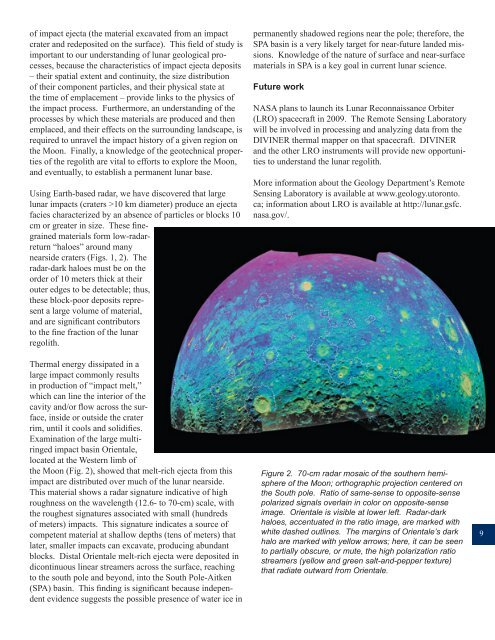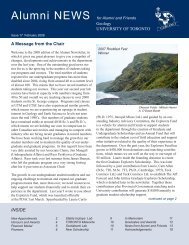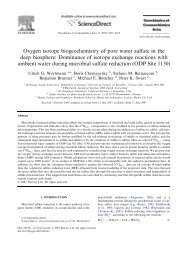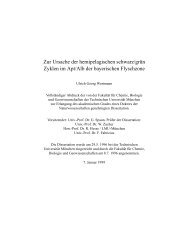Alumni News - Department of Earth Sciences, University of Toronto
Alumni News - Department of Earth Sciences, University of Toronto
Alumni News - Department of Earth Sciences, University of Toronto
You also want an ePaper? Increase the reach of your titles
YUMPU automatically turns print PDFs into web optimized ePapers that Google loves.
<strong>of</strong> impact ejecta (the material excavated from an impact<br />
crater and redeposited on the surface). This field <strong>of</strong> study is<br />
important to our understanding <strong>of</strong> lunar geological processes,<br />
because the characteristics <strong>of</strong> impact ejecta deposits<br />
– their spatial extent and continuity, the size distribution<br />
<strong>of</strong> their component particles, and their physical state at<br />
the time <strong>of</strong> emplacement – provide links to the physics <strong>of</strong><br />
the impact process. Furthermore, an understanding <strong>of</strong> the<br />
processes by which these materials are produced and then<br />
emplaced, and their effects on the surrounding landscape, is<br />
required to unravel the impact history <strong>of</strong> a given region on<br />
the Moon. Finally, a knowledge <strong>of</strong> the geotechnical properties<br />
<strong>of</strong> the regolith are vital to efforts to explore the Moon,<br />
and eventually, to establish a permanent lunar base.<br />
Using <strong>Earth</strong>-based radar, we have discovered that large<br />
lunar impacts (craters >10 km diameter) produce an ejecta<br />
facies characterized by an absence <strong>of</strong> particles or blocks 10<br />
cm or greater in size. These finegrained<br />
materials form low-radarreturn<br />
“haloes” around many<br />
nearside craters (Figs. 1, 2). The<br />
radar-dark haloes must be on the<br />
order <strong>of</strong> 10 meters thick at their<br />
outer edges to be detectable; thus,<br />
these block-poor deposits represent<br />
a large volume <strong>of</strong> material,<br />
and are significant contributors<br />
to the fine fraction <strong>of</strong> the lunar<br />
regolith.<br />
Thermal energy dissipated in a<br />
large impact commonly results<br />
in production <strong>of</strong> “impact melt,”<br />
which can line the interior <strong>of</strong> the<br />
cavity and/or flow across the surface,<br />
inside or outside the crater<br />
rim, until it cools and solidifies.<br />
Examination <strong>of</strong> the large multiringed<br />
impact basin Orientale,<br />
located at the Western limb <strong>of</strong><br />
the Moon (Fig. 2), showed that melt-rich ejecta from this<br />
impact are distributed over much <strong>of</strong> the lunar nearside.<br />
This material shows a radar signature indicative <strong>of</strong> high<br />
roughness on the wavelength (12.6- to 70-cm) scale, with<br />
the roughest signatures associated with small (hundreds<br />
<strong>of</strong> meters) impacts. This signature indicates a source <strong>of</strong><br />
competent material at shallow depths (tens <strong>of</strong> meters) that<br />
later, smaller impacts can excavate, producing abundant<br />
blocks. Distal Orientale melt-rich ejecta were deposited in<br />
dicontinuous linear streamers across the surface, reaching<br />
to the south pole and beyond, into the South Pole-Aitken<br />
(SPA) basin. This finding is significant because independent<br />
evidence suggests the possible presence <strong>of</strong> water ice in<br />
permanently shadowed regions near the pole; therefore, the<br />
SPA basin is a very likely target for near-future landed missions.<br />
Knowledge <strong>of</strong> the nature <strong>of</strong> surface and near-surface<br />
materials in SPA is a key goal in current lunar science.<br />
Future work<br />
NASA plans to launch its Lunar Reconnaissance Orbiter<br />
(LRO) spacecraft in 2009. The Remote Sensing Laboratory<br />
will be involved in processing and analyzing data from the<br />
DIVINER thermal mapper on that spacecraft. DIVINER<br />
and the other LRO instruments will provide new opportunities<br />
to understand the lunar regolith.<br />
More information about the Geology <strong>Department</strong>’s Remote<br />
Sensing Laboratory is available at www.geology.utoronto.<br />
ca; information about LRO is available at http://lunar.gsfc.<br />
nasa.gov/.<br />
Figure 2. 70-cm radar mosaic <strong>of</strong> the southern hemisphere<br />
<strong>of</strong> the Moon; orthographic projection centered on<br />
the South pole. Ratio <strong>of</strong> same-sense to opposite-sense<br />
polarized signals overlain in color on opposite-sense<br />
image. Orientale is visible at lower left. Radar-dark<br />
haloes, accentuated in the ratio image, are marked with<br />
white dashed outlines. The margins <strong>of</strong> Orientale’s dark<br />
halo are marked with yellow arrows; here, it can be seen<br />
to partially obscure, or mute, the high polarization ratio<br />
streamers (yellow and green salt-and-pepper texture)<br />
that radiate outward from Orientale.<br />
9








